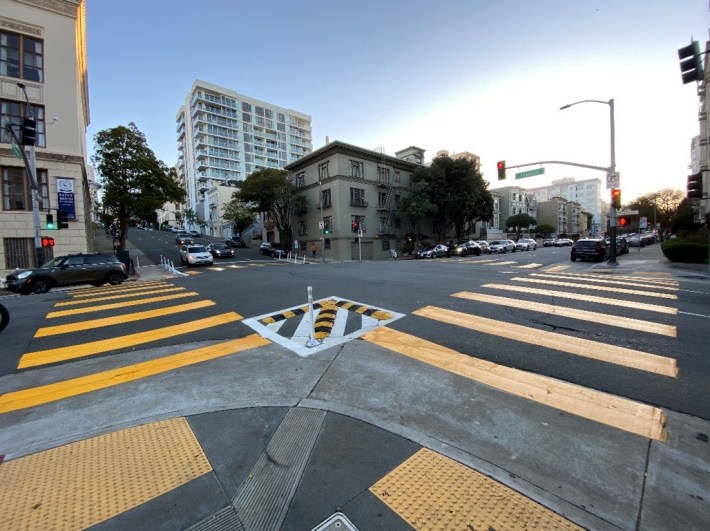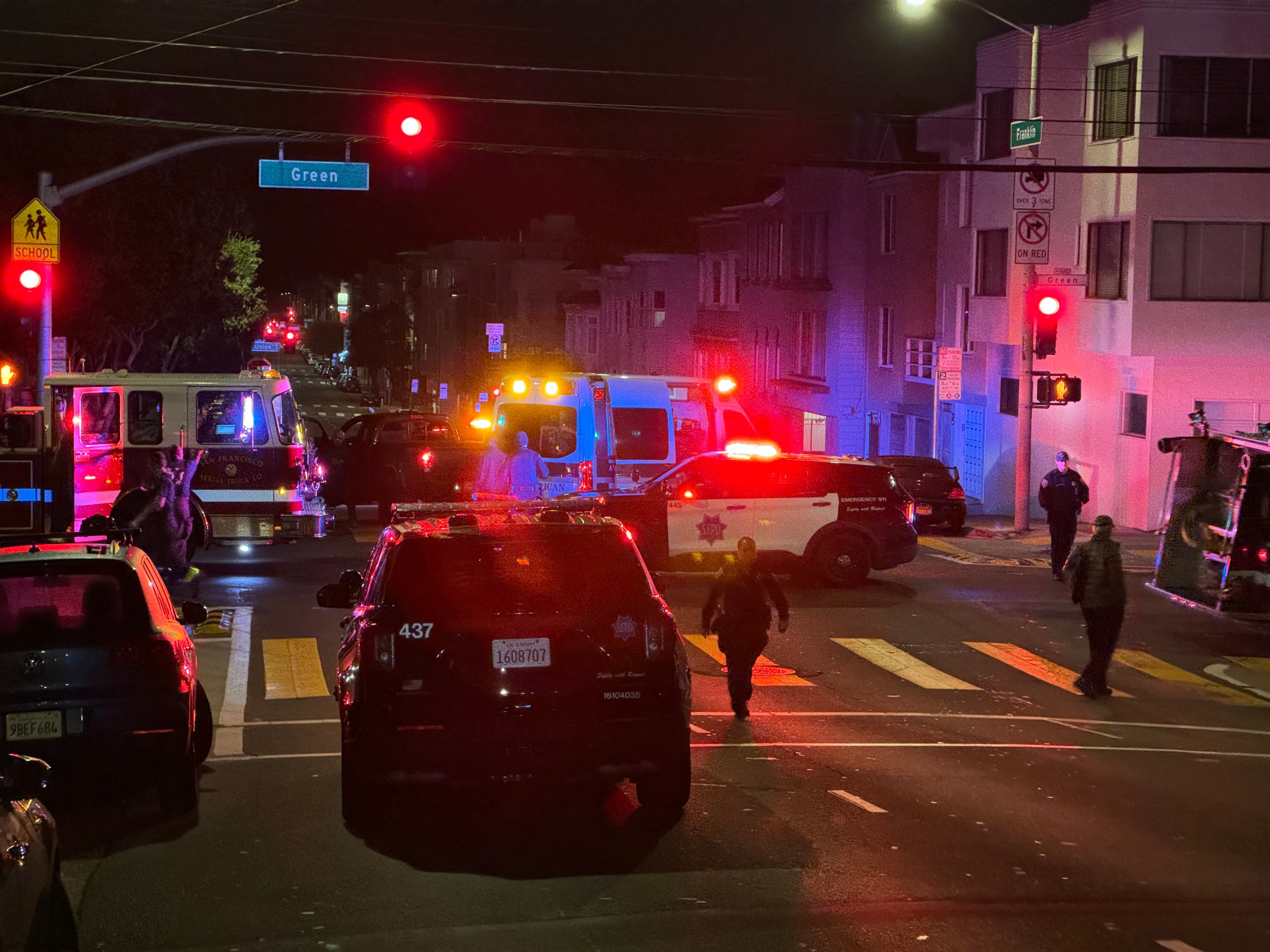Note: GJEL Accident Attorneys regularly sponsors coverage on Streetsblog San Francisco and Streetsblog California. Unless noted in the story, GJEL Accident Attorneys is not consulted for the content or editorial direction of the sponsored content.
Five overly wide lanes (two for parking, three for through traffic) encourage excessive speeds down Franklin Street. Sadly and predictably, in December yet another pedestrian fell victim to the city's unwillingness to prioritize safety over automobile throughput.
"I heard the crash outside my house. It sounded like a car-on-car crash because the impact was so severe," explained Barnett Trzcinski who, along with fellow advocate Shanan Delp, has long urged SFMTA to take real steps to reduce speeding on the corridor. "When I got there it was just the pickup truck and the person in the crosswalk."
Details are unknown about who the victim was or the extent of injuries. But Trzcinski told Streetsblog that "when you live on the street you see this stuff happen on a regular basis." According to the city's public database, motorists have killed at least three pedestrians on Franklin since 2014.
Streetsblog readers will recall that educator Andrew Zieman was killed by a motorist in front of Sherman Elementary at Union Street in November of 2021. SFMTA promised a list of "quick build" improvements, including a lane reduction. That was removed because of concerns it might cause traffic backups. SFMTA's communications staff previously claimed, regarding Franklin, that "safety is the top priority for all of our projects." But that was followed by a big fat caveat: "The public expects us to keep an eye on traffic flow on the city’s few arterial roads even if pure LOS is not the top Key Performance Indicator."
LOS, or "Level of Service," is a measure of potential traffic backup. It's possible to prioritize LOS or safety, not both. As Delp discovered in September of 2022, LOS was indeed prioritized.
Meanwhile, "the team will prioritize studying potential signal-timing adjustments to lower speeds," wrote SFMTA's Julia Malmo in a recent email to Delp and Trzcinski about the ongoing carnage. "We anticipate implementing any signal timing adjustments this spring, and will collect data afterwards to evaluate the effectiveness of the changes and inform possible further actions on Franklin Street." There's also a proposal to bring red-light cameras to Franklin.
SFMTA has also installed paint and plastic curb extensions at some locations, but they have not reduced the main culprit: excessive speeds. That's because they won't implement the obvious solution of reducing and narrowing lanes.
Meanwhile, Supervisor Catherine Stefani's office hasn't been much help, despite an earlier promise to "... consider every possible intervention to reduce traffic speeds along this corridor."
Somewhere along the way that changed to "...the pathway forward must be thoughtfully considered, particularly with regard to side streets off Franklin that have the potential to be significantly impacted by any alterations to Franklin," wrote Lorenzo Rosas, an aide to Stefani, in a recent email addressing the need to slow down traffic on Franklin. "We’ve already seen several incidents on Green Street in the recent past (such as the hit-and-run on Laguna and Green), and it’s imperative that SFMTA consider the potential of side streets that aren’t designed for high car volume facing the brunt of frustrated drivers looking to circumvent any speed mitigation efforts on Franklin."
As Trzcinski correctly pointed out in an email response to Rosas, this ignores the fact that reducing capacity and speed doesn't just slow cars in a vacuum, forcing drivers to take different routes -- it also encourages more people to walk and bike.
"Posing this as a zero-sum game between two or more streets is simply incorrect," wrote Trzcinski. "All streets stand to benefit when we make each street safer for all of its residents. There is copious scientific and engineering literature on this point (which the SFMTA knows) - a phenomenon called 'traffic evaporation,' which is the corollary to induced demand."
SFMTA is "...doing the absolute basic improvements on the high-injury network, and nothing that will address speed on streets where speed is an issue," wrote Walk San Francisco's Jodie Medeiros, in an email about Franklin and other streets on the city's 'High Injury Network.'
"This is incredibly frustrating and disappointing," she wrote, adding that "others will be hurt because of their lack of follow-through."
"At this point based on the language from Julia Malmo, and despite what Jeff Tumlin says in public, the SFMTA is not yet committed to improvements on the whole high injury network this year," wrote Trzcinski.

"They started by saying one of their goals was to slow down speeds," said Trzcinski. Instead, all they're doing is the usual 'better-than-nothing' paint and plastic band-aids. "They just added the corner treatments."





